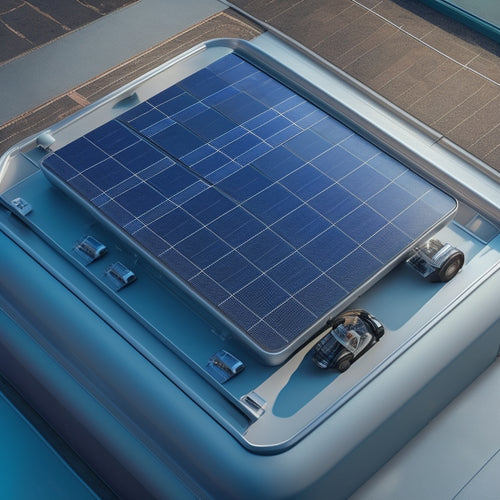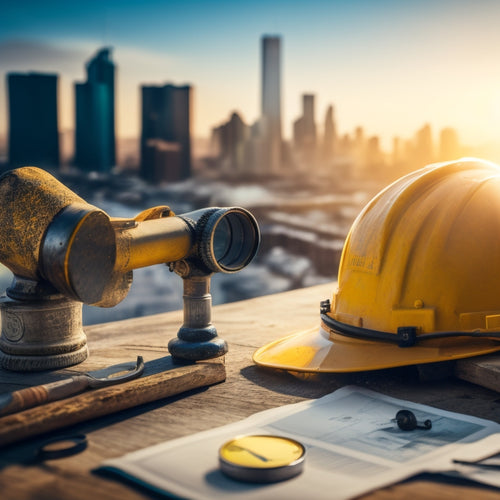
Conducting an Energy Audit for Your House of Worship
Share
To conduct an energy audit for your house of worship, start by evaluating energy usage patterns through reviewing past utility bills, identifying peak consumption periods and anomalies. Next, identify energy-wasting opportunities by inspecting outdated systems, worn-out seals, and inefficient appliances. Evaluate your building's envelope efficiency by checking for gaps, proper sealing, and insulation. Analyze your lighting system's efficiency by replacing incandescent bulbs with LEDs and optimizing ballast performance. Finally, prioritize energy-saving recommendations based on cost savings, feasibility, and stakeholder buy-in. By doing so, you'll be well on your way to discovering significant energy and cost savings – and there's more to discover.
Key Takeaways
• Review past utility bills to identify peak energy consumption periods and anomalies in energy usage patterns.
• Identify energy-wasting opportunities in outdated lighting, HVAC systems, seals, gaskets, and inefficient appliances.
• Evaluate the building envelope's efficiency by inspecting walls, windows, doors, and roof coatings for gaps, cracks, and insulation.
• Analyze lighting system efficiency by upgrading to LEDs, optimizing ballast performance, and installing occupancy sensors and timers.
• Prioritize energy-saving recommendations based on cost savings potential, implementation feasibility, and stakeholder buy-in.
Assessing Energy Usage Patterns
To accurately assess energy usage patterns in your house of worship, start by reviewing past utility bills to identify peak energy consumption periods and anomalies. This will give you a clear picture of when and how energy is being used in your building. Look for patterns, such as higher energy usage during weekdays or Sundays, and note any unusual spikes or dips in energy consumption.
Next, install energy meters to track energy usage in real-time. This will provide more detailed information on energy consumption and help you identify areas where energy is being wasted. Consider installing meters on specific circuits or equipment, such as HVAC systems or lighting, to get a more granular view of energy usage.
Identifying Energy-Wasting Opportunities
Identifying Energy-Wasting Opportunities
In order to pinpoint energy-wasting opportunities, it's crucial to focus on areas where energy is being used inefficiently or unnecessarily, such as in outdated lighting or HVAC systems, worn-out seals and gaskets, or inefficient appliances and equipment. As you conduct your energy audit, it's crucial to identify these areas to maximize energy savings.
Start by performing a waste detection exercise to identify potential energy drains. This involves a thorough walk-through of your facility, taking note of areas where energy might be wasted. Take a closer look at your lighting, HVAC systems, and appliances to determine if they're energy-efficient.
Next, create an energy map to visualize your energy usage patterns. This will help you identify areas where energy is being wasted and prioritize opportunities for improvement.
Evaluating Building Envelope Efficiency
You'll want to shift your attention to the building envelope, which includes the walls, windows, doors, and roof, to evaluate how well they're preventing heat from escaping and warm air from entering. Check for any gaps or cracks in the walls, windows, and doors, as these can be significant sources of energy loss. Make sure that all doors and windows are properly sealed and contemplate adding weatherstripping if necessary.
Next, inspect the wall insulation to verify it's adequate and properly installed. You may want to contemplate adding insulation to your walls if it's lacking.
Moving on to the roof, inspect the roof coatings to verify they're in good condition. If your roof is old or damaged, contemplate replacing it with a new one that's energy-efficient. You may also want to think about applying a cool roof coating to reduce heat gain during the summer months. Additionally, check for any signs of water damage or leaks in the roof, as these can lead to energy loss and structural damage.
Analyzing Lighting System Efficiency
About 20-30% of your house of worship's energy consumption is attributed to its lighting system, making it an essential area to scrutinize for inefficiencies. When analyzing your lighting system's efficiency, it's important to assess the type and quality of lighting used, as well as the lighting controls and sensors in place.
| Lighting Component | Energy Efficiency Opportunities |
|---|---|
| Lamps | Replace incandescent bulbs with LEDs, which use significantly less energy and last longer |
| Ballasts | Optimize ballast performance through proper maintenance and replacement with energy-efficient alternatives |
| Controls | Install occupancy sensors and timers to reduce unnecessary lighting usage |
| Fixtures | Upgrade to energy-efficient fixtures with high lumen-per-watt ratings |
| Lumen Depreciation | Regularly clean and maintain fixtures to prevent lumen depreciation and ensure optimal light output |
Prioritizing Energy-Saving Recommendations
Now that you've assessed the energy efficiency of your house of worship's lighting system, it's time to prioritize the energy-saving recommendations based on their potential impact, cost, and feasibility. This step is important in ensuring that you're tackling the most critical areas first, given your budget constraints.
To prioritize effectively, consider the following factors:
-
Cost savings potential: Which recommendations will yield the highest energy savings?
-
Implementation feasibility: Which projects can be completed in-house, and which require external contractors?
-
Stakeholder buy-in: Which recommendations align with the values and goals of your congregation and stakeholders?
-
Urgency: Are there any recommendations that address critical safety or maintenance issues?
-
Simple payback period: Which projects will pay for themselves the fastest, providing a quick return on investment?
Frequently Asked Questions
Can a Volunteer Team Conduct an Energy Audit, or Is a Professional Needed?
You can assemble a volunteer team to conduct an energy audit, but be aware that varying skill levels, training requirements, and team dynamics may create an expertise gap, potentially leading to incomplete or inaccurate results.
How Long Does a Typical Energy Audit Process Take to Complete?
"When you're ready to roll up your sleeves, expect the energy audit process to take around 2-5 weeks, depending on the complexity of your facility and energy scheduling, with the actual audit timeline varying from a few hours to several days."
Are Energy Audits Only for Old Buildings, or New Ones Too?
You might think energy audits are only for old buildings, but they're beneficial for new ones too, regardless of building history or construction phases, as they help identify areas for improvement in energy efficiency.
Will an Energy Audit Disrupt Our Daily Worship Services and Activities?
You're concerned that an energy audit might disrupt your daily worship services and activities, impacting your ministry. Don't worry, scheduling concerns can be addressed by working with the auditor to minimize disruptions, ensuring a seamless process that respects your community's needs.
Are Energy Audit Costs Reimbursable Through Government Incentives?
Imagine finding a $20 bill on the sidewalk - it's like discovering hidden savings! You're likely eligible for grant opportunities and rebate eligibility, making energy audit costs reimbursable through government incentives, so you can focus on worship, not expenses.
Related Posts
-

Top Solar Panels for Car Battery Maintenance
When selecting top solar panels for car battery maintenance, consider high-efficiency models with high wattage output...
-

What You Need to Know About Permits and Inspections
You need to navigate the complex landscape of permits and inspections to guarantee your project complies with local z...
-

Reduce Solar Panel Cost for Your Small Home
By evaluating your energy needs, choosing the right installer, and selecting cost-effective solar panel options, you ...


